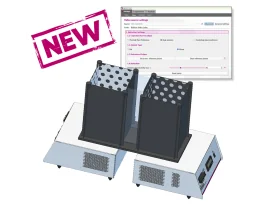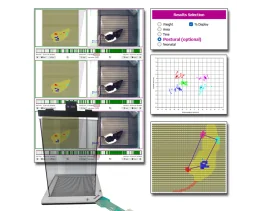Authors
Roth L, Van Dam D, Van der Donckt C, Schrijvers DM, Lemmens K, Van Brussel I, De Deyn PP, Martinet W, De Meyer GR
Lab
Laboratory of Physiopharmacology, University of Antwerp, Antwerp, Belgium
Journal
Physiol Behav.
Abstract
Apolipoprotein E deficient (ApoE(-/-)) mice with a heterozygous mutation in the fibrillin-1 gene (Fbn1(C1039G+/-)) show spontaneous atherosclerotic plaque ruptures, disturbances in cerebral flow and sudden death when fed a Western-type diet (WD). The present study focused on motor coordination and spatial learning of ApoE(-/-) Fbn1(C1039G+/-) mice on WD for 20 weeks (n=21). ApoE(-/-) mice on WD (n=24) and ApoE(-/-) Fbn1(C1039G+/-) mice on normal diet (ND, n=21) served as controls. Starting from 10 weeks of diet, coordination was assessed every two weeks by the following tests: gait analysis, stationary beam, wire suspension and accelerating rotarod. The Morris water maze test was performed after 13 weeks of diet to study spatial learning. At the end of the experiment (20 weeks of WD), the mice were sacrificed and the brachiocephalic artery and brain were isolated. From 12 weeks onward, gait analysis of ApoE(-/-) Fbn1(C1039G+/-) mice on WD revealed a progressive increase in track width as compared to ApoE(-/-) mice on WD and ApoE(-/-) Fbn1(C1039G+/-) mice on ND (at 20 weeks: 29.8±0.6 mm vs. 25.8±0.4 mm and 26.0±0.5 mm). Moreover, the stationary beam test showed a decrease in motor coordination of ApoE(-/-) Fbn1(C1039G+/-) mice on WD at 18 and 20 weeks. The wire suspension test and accelerating rotarod could not detect signs of motor impairment. Spatial learning was also not affected. Histological analysis of the brachiocephalic artery showed larger and more stenotic plaques in ApoE(-/-) Fbn1(C1039G+/-) mice on WD. Furthermore, the parietal cortex of ApoE(-/-) Fbn1(C1039G+/-) mice on WD showed pyknotic nuclei as a sign of hypoxia and the percentage of pyknosis correlated with track width. In conclusion, gait analysis may be an efficient method for analyzing hypoxic brain damage in the ApoE(-/-) Fbn1(C1039G+/-) mouse model. This test could be of value to assess the effect of potential anti-atherosclerotic therapies in mice.
BIOSEB Instruments Used
Aron Test or Four Plates Test (LE830),Rotarod (BX-ROD)
Source :

 Douleur - Allodynie/Hyperalgésie Thermique
Douleur - Allodynie/Hyperalgésie Thermique Douleur - Spontanée - Déficit de Posture
Douleur - Spontanée - Déficit de Posture Douleur - Allodynie/Hyperalgésie Mécanique
Douleur - Allodynie/Hyperalgésie Mécanique Apprentissage/Mémoire - Attention - Addiction
Apprentissage/Mémoire - Attention - Addiction Physiologie & Recherche Respiratoire
Physiologie & Recherche Respiratoire




































 Douleur
Douleur Système Nerveux Central (SNC)
Système Nerveux Central (SNC)  Neurodégénérescence
Neurodégénérescence Système sensoriel
Système sensoriel Système moteur
Système moteur Troubles de l'humeur
Troubles de l'humeur Autres pathologies
Autres pathologies Système musculaire
Système musculaire Articulations
Articulations Métabolisme
Métabolisme Thématiques transversales
Thématiques transversales Congrès & Meetings
Congrès & Meetings 